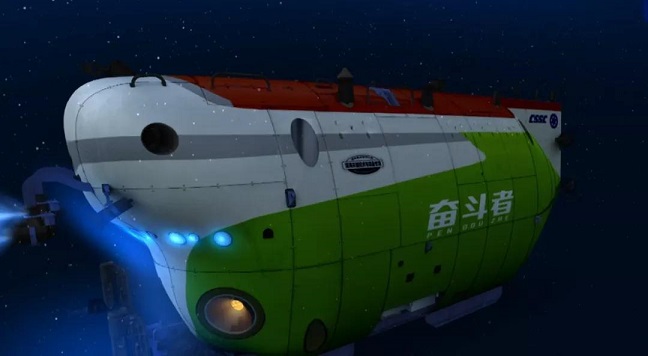At around 17:00 Beijing time, the "Struggle" manned submersible, which successfully sat on the bottom of 10,909 meters, surfaced and was recovered to the mother ship. 10909 meters is also the deepest record for China's manned submersible.
Today's deployment work was carried out at 4 o'clock in the morning Beijing time. At 8:12, after the "Struggle" successfully sat on the bottom of the Mariana Trench, the three submariners carried out about 6 hours of sampling work on the seabed-this is the longest design time for the "Struggle" subsea operation.
The so-called sitting on the bottom is to allow the submersible to artificially land on the seabed in consideration of the speed, attitude and seabed geology of the submersible. Some people describe it as "stepping on the brake" to facilitate subsequent scientific research on the seabed. And homework.

During the submarine operation, through the acoustic communication system carried by the submersible, the submarine expresses the feeling of cruising ten thousand meters: "The seabed of ten thousand meters is wonderful."
In order to ensure that the submariners can eat comfortably and smoothly, the food package prepared by the staff for the submariners includes sports drinks, washed fragrant pears, and a "fried egg + fried noodle" love package for one person.
In 2016, the full-sea deep manned submersible project for the development of 10,000-meter submersibles was officially established.
Ye Cong, deputy director of the 702 Office of China State Shipbuilding Corporation and chief designer of the Struggle, told reporters that going deep into the sea is not easy. The first problem is the high pressure brought by the sea. The 10,000-meter manned submersible has to withstand 1,000 atmospheres, which is equivalent to 2,000 African elephants stepping on a person's back. Such a large pressure on the submersible poses a huge challenge to the material and structural design of the submersible.
In addition to withstanding the huge water pressure, the Struggle will also carry relevant personnel and a series of scientific facilities to complete scientific research in the water. This further increases the difficulty of manufacturing.
"Struggle" has the ability to cover 100% of the global oceans, which comes from the support of some key technologies, such as the spherical shell of the manned submersible, and buoyancy materials. For example, as one of the main structures of the submersible, the manned submersible spherical shell can be said to be extreme design and extreme manufacturing.
"Struggle" uses titanium alloy material. Researchers boldly overturned the original design and changed the welding method used before. The so-called melon petal welding method is to first manufacture the watermelon petals and then weld them into a whole ball, but this method has many welds and a long construction period. The 10,000-meter manned submersible uses hemispherical welding, which reduces the number of welds and makes the process more difficult, but the reliability is significantly improved.
This sea trial mission adopted the "dual ship" support model, that is, in order to support the "Struggle" to successfully complete the sea trial, the "exploration 1" support ship and the "exploration 2" support ship "double mother ship" support were used Mode, a total of 120 members of the scientific research team can be boarded.
"Discover One" has a total length of 94.45 meters, a width of 17.9 meters, a displacement of 6,250 tons, and a battery life of more than 10,000 nautical miles. "Discovery II" was transformed from an ocean engineering ship and was completed in June this year. It is worth mentioning that six key equipment including the "Exploration No. 2" CTD winch and retractable device, 100-ton gantry submersible deployment and recovery system, and 10 tons and 20-meter folding boom telescopic cranes have all been localized.
In 1986, China successfully developed the first manned submersible, the 7103 lifeboat. Although it can only dive 300 meters and the speed is only four knots, it opens a new chapter in my country's manned deep diving. In terms of manned submersibles, my country has successively developed the "Jiaolong" and "Deep Sea Warrior", as well as the "Haidou", "Haiyan" and "Haiyi" unmanned submersibles.
The 10,000-meter abyss under the sea can be described as a "no man's land" for scientific research, and the full-sea deep manned submersible is a scientific research equipment for "no man but no one". Deep-sea technology represented by abyssal entry technology and abyssal detection technology represents the top level of the current international deep-sea engineering technology field. Looking at the world, there are only a handful of all-sea deep submersibles that have visited an abyss of 10,000 meters.
Prior to this, on October 27, the Struggle successfully dived to 10058 meters in the Mariana Trench. In recent years, China has participated in more than 40 core units of manned submersibles, and some installation-level projects have even introduced PK mechanisms.
China has already had a 10,000-meter unmanned submersible before, why is it necessary to develop a 10,000-meter manned submersible? Bao Gengsheng, a researcher at the Institute of Deep Sea Science and Engineering of the Chinese Academy of Sciences, explained that from a technical point of view, the development of a 10,000-meter manned submersible will promote breakthroughs in a series of key technical issues. From a scientific point of view, manned submersibles are more maneuverable and capable of cruising during underwater scientific research, and can carry more scientific research equipment. Therefore, there must be both unmanned and manned.

